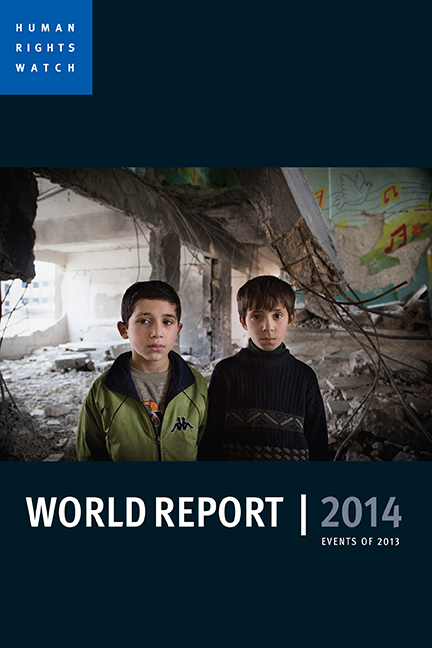Book contents
- Frontmatter
- Dedication
- HUMAN RIGHTS WATCH
- Table of Contents
- Foreword
- Rights Struggles of 2013: Stopping Mass Atrocities, Majority Bullying, and Abusive Counterterrorism
- The Human Rights Case for Drug Reform How Drug Criminalization Destroys Lives, Feeds Abuses, and Subverts the Rule of Law
- Putting Development to Rights: Integrating Rights into a Post-2015 Agenda
- The Right Whose Time Has Come (Again) Privacy in the Age of Surveillance
- Photo Essays
- AFRICA
- AMERICAS
- ASIA
- EUROPE AND CENTRAL ASIA
- MIDDLE EAST AND NORTH AFRICA
- UNITED STATES AND CANADA
- 2013 HUMAN RIGHTS WATCH PUBLICATIONS
- Acknowledgments
United States
Published online by Cambridge University Press: 07 May 2022
- Frontmatter
- Dedication
- HUMAN RIGHTS WATCH
- Table of Contents
- Foreword
- Rights Struggles of 2013: Stopping Mass Atrocities, Majority Bullying, and Abusive Counterterrorism
- The Human Rights Case for Drug Reform How Drug Criminalization Destroys Lives, Feeds Abuses, and Subverts the Rule of Law
- Putting Development to Rights: Integrating Rights into a Post-2015 Agenda
- The Right Whose Time Has Come (Again) Privacy in the Age of Surveillance
- Photo Essays
- AFRICA
- AMERICAS
- ASIA
- EUROPE AND CENTRAL ASIA
- MIDDLE EAST AND NORTH AFRICA
- UNITED STATES AND CANADA
- 2013 HUMAN RIGHTS WATCH PUBLICATIONS
- Acknowledgments
Summary
The United States has a vibrant civil society and media that enjoy strong constitutional protections. Yet its rights record is marred by abuses related to criminal justice, immigration, national security, and drug policy. Within these areas, victims are often the most vulnerable members of society: racial and ethnic minorities, immigrants, children, the elderly, the poor, and prisoners.
Revelations in 2013 of extensive government surveillance and aggressive prosecutions of whistleblowers raised concerns about infringement of privacy rights and freedom of expression, generating a firestorm of international protest against US practices.
Federal policymakers proposed reforms to harmful longstanding immigration and sentencing laws and policies. The outcome of these initiatives was uncertain at time of writing.
A renewed commitment by President Barack Obama to close the Guantanamo Bay detention facility remained unfulfilled. Lack of transparency made it impossible to assess the implementation of promised reforms to the practice of “targeted killings” abroad, including through use of unmanned aerial drones; new information on individual strikes found instances of violations of international humanitarian and human rights law.
Harsh Sentencing
The US has the largest reported incarcerated population in the world, and by far the highest rate of imprisonment, holding 2.2 million people in adult prisons or jails as of year-end 2011.
Mass incarceration reflects three decades of harsh state and federal sentencing regimes, including increased use of life and life without parole sentences, high mandatory minimum sentences, and “three strikes” laws. The Sentencing Project reported that one in nine US prisoners are serving a life sentence.
The growing number of elderly prisoners poses a serious challenge to correctional authorities: as of 2011, the latest year for which complete numbers are available, 26,136 persons aged 65 and older were incarcerated in state and federal prisons, up 62 percent in five years.
In a positive step, the US Department of Justice in August announced revisions to its rules for reviewing requests for compassionate release of elderly or disabled prisoners, making more federal inmates eligible for this rarely used mechanism.
Also in August, US Attorney General Eric Holder instructed federal prosecutors to try to avoid charges carrying mandatory minimum sentences for certain lowlevel, nonviolent drug offenders. Though welcome, this policy change still leaves many drug offenders subject to disproportionately long mandatory sentences. Legislative efforts to grant judges more discretion in such cases are under debate.
- Type
- Chapter
- Information
- World Report 2014Events of 2013, pp. 642 - 656Publisher: Bristol University PressPrint publication year: 2014

